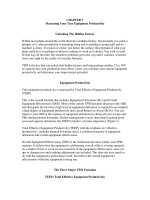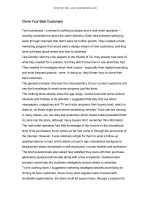Tài liệu Managing Your Suppliers as a Resource Introduction Several years ago, I visited Camco, GE''''s doc
Bạn đang xem bản rút gọn của tài liệu. Xem và tải ngay bản đầy đủ của tài liệu tại đây (37.18 KB, 8 trang )
Managing Your Suppliers as a Resource
Introduction
Several years ago, I visited Camco, GE's appliance manufacturing and
distribution business unit in Canada. Camco was the site of one of the earliest,
most successful, make-to-order manufacturing systems in the world. Through
insight and innovation, Camco's managers developed a manufacturing process that
was widely followed.
I recall the manager of the manufacturing unit telling me that their suppliers
were one of their most valuable resources, but they had not realized it until they
engaged them in the new system. To the surprise of Camco's managers, many of
their most important suppliers quickly adopted the make-to-order system in their
own businesses, significantly compressing cycle time throughout the channel, and
offered powerful new process innovations that helped Camco in its own business.
This discussion came to mind recently when I met with the purchasing
group of a major equipment manufacturer. They had identified a number of
opportunities to coordinate with their suppliers in mutually beneficial ways. They
felt stuck, however, because they did not have the resources to develop these
initiatives to the point where they could engage the suppliers in the many
opportunities they identified.
During the course of the meeting, the purchasing group came to realize that
they were not using their suppliers as a resource. Instead, they were tacitly
assuming that they would have to create projects to develop ways to instruct the
suppliers on how to coordinate with them.
By the end of the meeting, a more powerful alternative became clear.
Rather than developing their own intercompany processes for their suppliers, they
could manage the suppliers and use them as a resource. This involved focusing
their efforts on defining clearly what their needs were, and what flexibility they
had in their own internal processes. Then, they could invite their best suppliers to
engage with them, having the suppliers suggest innovative ways to develop new
customer-supplier business efficiencies.
This equipment manufacturer was a very important account for many of its
most significant suppliers. The suppliers had ample resources to devote to
improving their operating ties with this important customer. By using these
suppliers as a resource, the company gained an opportunity to leverage its limited
supplier management resources, and both the company and its suppliers faced new
possibilities for huge mutual gain.
Many companies have supplier relationships that are tacitly adversarial.
Some have developed supplier management programs which specify expected
supplier performance in areas such as on-time deliveries and order-fill rate. These
typically involve penalties for deficient performance. But few companies are
willing to go through the process of identifying and removing obstacles to efficient
joint business processes on both sides of the relationship.
Innovative supplier management, using your suppliers as a resource, allows
both companies to move past the traditional adversarial relationship toward a
partnership with deep mutual value creation.
Innovative supplier management
In Japan, supplier management is viewed as an essential management
function. Suppliers are viewed as the "hidden factory." This perspective is largely
missing in all too many companies.
In many companies, the cost of materials and components exceeds the
internal value-added through manufacturing or assembly. Yet the fundamental
nature of staffing and process improvement for internal projects versus external,
supplier-related projects is often hugely different.
Internal process improvement projects are generally well staffed, and
develop knowledge systematically through techniques like process mapping.
Supplier management projects, by contrast, tend to be inadequately staffed,
somewhat ad hoc, and rife with assumptions rather than systematic knowledge
development.
In a few industries, such as those that provide consumer products to major
retailers, innovative suppliers have stepped up to the challenge. (See Supply Chain
Management in a Wal-Mart World.) These innovative suppliers have even gone a
step further, offering different levels of customer integration to different sets of
accounts, depending on account importance and account willingness and ability to
innovate.
In these sophisticated relationships, the best suppliers implicitly penalize
accounts that are stuck in adversarial mode and favor those that are adept at
creating win-win relationships. The best suppliers seek situations where they can
be managed as a resource, creating innovations that benefit both customer and
supplier; they shun situations where supplier management is a one-sided affair.
Key success factors
Three factors are especially important in developing an effective supplier
management process: partner selection, relationship-building, and contracting.
Many supplier management projects fail because adequate care is not taken in
selecting the right supplier partners. In order for a deep, innovative partnership to
develop, five key factors must be present:
Real new value—this value must be measured, observed by both
companies, and fairly divided, a process that is essential to keep the partnership
vital, even if the original sponsoring managers exit.
Complementary specialties and capabilities—there must be a good fit and
adequate flexibility that will endure over a considerable period of time.
Strategic alignment—developing a deep partnership with a major supplier
often changes the relationship with competing suppliers, and the converse is true
for the supplier.
Willingness to partner—there must be a lack of internal organizational
conflict on both sides of the relationship.
Ability to implement—both companies need to qualify each other to ensure
that they both have the ability to follow through on their intentions over a
significant period of time.
All too often, companies actually initiate supplier partnership programs
with the first supplier that approaches them, whether the supplier fits and is well-
qualified to follow through or not. Partner selection is far too important not to be
managed proactively.
Relationship-building requires finesse. Often, it takes a few months to get
past festering old issues. A channel map is a key analytical instrument at this
stage. It provides a broad view of the customer-supplier product flow patterns, and
actual channel performance by tracing the product flow through the channel.
A channel map has three components:
(1) a diagram of the information and product flow at each channel stage,
including handling, storage, moving, processing, etc.;
(2) a quantitative analysis, or representative model, of product
accumulation and movement over a typical time period; and
(3) rough estimates of the costs at each stage.
With the view that a channel map provides, you and your supplier can
identify the biggest obstacles to efficient product flow between the companies.
This is important because a few well-designed intercompany process links usually
can provide a large portion of the potential benefits.
" Showcase" projects are particularly effective at this stage. These differ
from pilot projects in important ways. A showcase offers the opportunity to
experiment with a program that is only roughly defined, learning by doing in the
process. A pilot project, on the other hand, is designed to "try out" a program that
was previously analyzed and approved. Once you develop a working model of a
new customer-supplier relationship in showcase mode, it is much easier to sell it
into both organizations.
Start small
Often, managers think first of developing supplier innovations with their
most important suppliers. This is generally a mistake. The most effective place to
start is to work with a relatively small, very capable, innovative supplier for whom
your company is an extremely important customer. This situation has the
conditions most favorable for creating new innovations that can later be scaled
throughout your supplier base. Major suppliers, on the other hand, often are more
difficult to work with and innovation is more risky with so much at stake.
Once an innovation is developed, contracting is very important. This is a
complex topic, but a few underlying principles provide directional guidance. A
good contract will have effective incentives for both parties to continue to deepen
the relationship and to find new ways to create mutual value over time. In
addition, the contract should have a "migration out" provision that will specify
how to restore the status quo if the relationship ends and a new partner needs to be
obtained.
Developing an effective contract is as much an art as a science, because a
productive relationship should and will evolve in new, mutually-beneficial ways.
Effective contracts are liberating, not confining.
Your suppliers can be your most valuable hidden resource. If your supplier
management function is adversarial in tone, your suppliers will respond in kind.
But, if your supplier management function sets its sights on innovation and value
creation, you can find a clear pathway to success.









